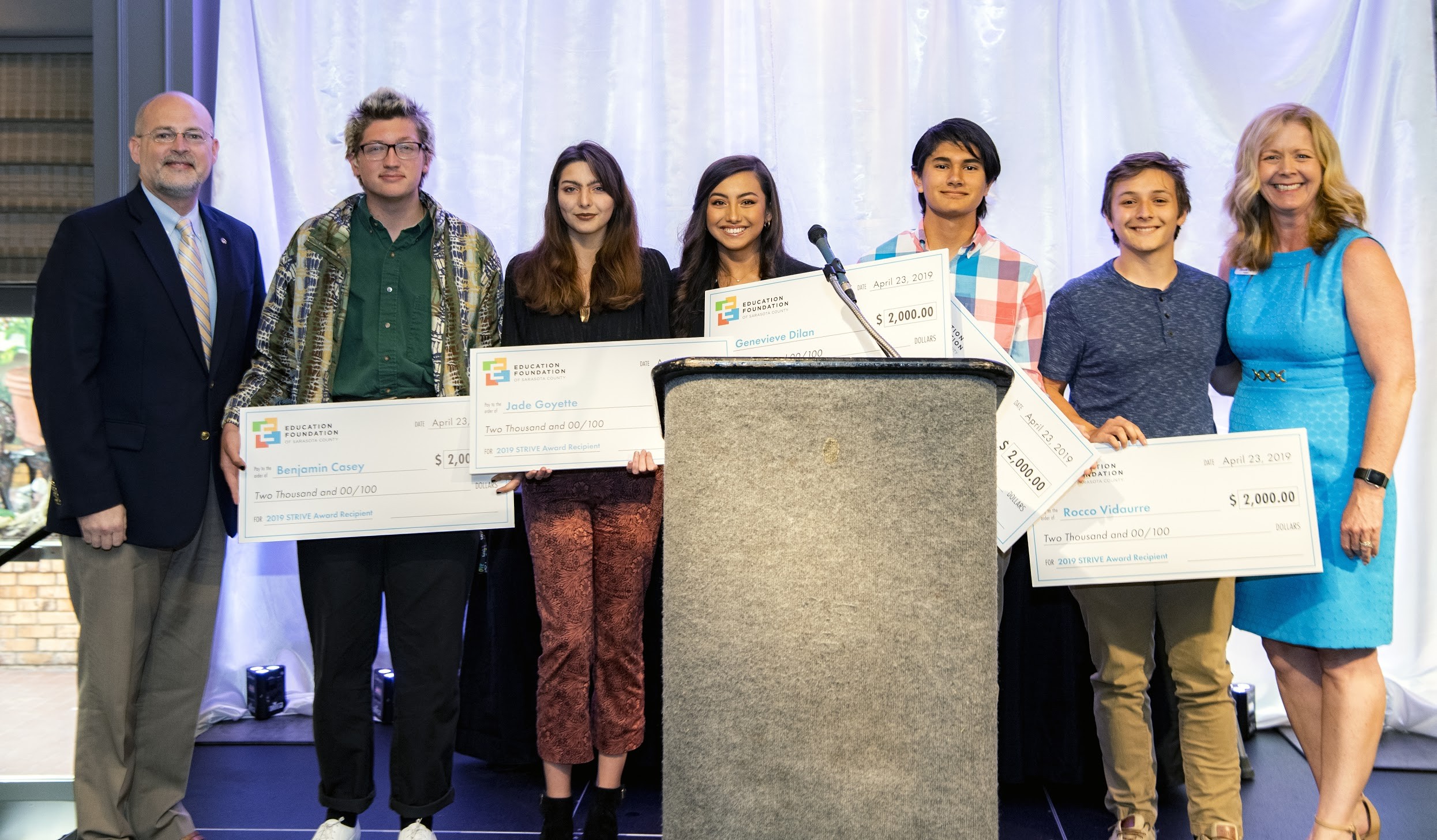Can We Match Opportunity with Expectation?
Guest Correspondence
SRQ DAILY
SATURDAY MAY 4, 2019 |
BY JENNIFER VIGNE
Photo: Jennifer Vigne (right), EFSC president, on stage with student STRIVE recipients from Pine View School.
In last month’s column I wrote about the importance of individuals and organizations remembering their purpose—their why.
At the annual STRIVE Awards luncheon held recently, the Education Foundation of Sarasota County had the privilege of recognizing 62 juniors and seniors who individually and collectively represent our organization’s WHY. Their stories show impressive resilience, grit and courage in overcoming setbacks to graduate from high school.
There was an earlier time when educators, parents and advocates could leave an event like STRIVE Awards, comfortable in the expectation that students graduating with a high school diploma had good opportunities for going forward with their next chapter.
That premise does not hold true now as the 21st century forces us to address harsh realities. Every one of this year’s STRIVE students representing the Class of 2019 has a plan for postsecondary education. Their choices include technical college, military service, and two-year and four-year college degrees. Some aspire to earn advanced degrees.
They are wise to further their education. Their personal success and our society’s well-being depend on innovative, educated young people being prepared to solve complex problems in the modern world.
In short, this is why the EFSC invests in meaningful and important work that goes beyond supporting students to get their high school diplomas.
The emphasized words in the following underscore our bigger purpose: Our vision is to see students graduate from high school prepared to successfully get to and through their postsecondary paths and equipped to flourish in productive careers.
Yet, we know, and a growing body of research supports, that success in high school doesn’t necessarily translate to success in college and other post-secondary pursuits.
The reasons for this are numerous and complex and are explored in a timely and evidence-based research document, “The Opportunity Myth,” as shown in the following excerpt:
“For years, getting more students through high school has been a huge goal of educators and policymakers across the country. The effort has largely paid off: High school graduation rates have risen steadily, past 80 percent. (Note: Sarasota County Schools 2017-18 graduation rate was 89.8 percent.)
“When students collect their diplomas, they believe they are prepared for what’s next—because that’s what they’ve been told throughout their K-12 years.”
Based on weighty research, “The Opportunity Myth” cites key resources behind high-quality academic experiences, how to close the outcomes gap for students who are behind their peers, creating programs and structures that address inequities of the status quo, the importance of high expectation environments, the damaging effects of implicit bias, and more.
Another excerpt further supports the authors’ points:
“Millions of students across the country are working hard to get through school, only to find themselves ill-prepared to live the lives they hope for. They’re planning their futures on the belief that doing well in school creates opportunities—that showing up, doing the work, and meeting their teachers’ expectations will prepare them for what’s next. They believe that for good reason: We’ve been telling them so.”
“The Opportunity Myth” conclusion asks us to consider what it would take to make students’ school opportunities a reality.
This research is being discussed on a statewide level. The authors followed up their findings with examples of how to improve, and several local communities are participating in discussions about how to apply their ideas in partnership with organizations like Impact Florida and TNTP.
The EFSC sees value in raising awareness of this report’s depth and complexity and its thought-provoking questions that cause us to critically examine structures that were designed based on inaccurate and possibly outdated assumptions that aren’t supported by facts.
As painful as critical self-analysis might be, we do have choices. A place to start could be heeding what research suggests are four key resources that are necessary to students’ success.
As defined by the researchers, the four resources students need at school are: (1) consistent opportunities to work on grade-appropriate assignments; (2) strong instruction where students do most of the thinking; (3) deep engagement in what they’re learning; and (4) teachers who hold high expectations for students.
We look forward to delving more deeply into this important research, and we invite community education champions to join the discussion.
Jennifer Vigne is president of the Education Foundation of Sarasota County.
Photo: Jennifer Vigne (right), EFSC president, on stage with student STRIVE recipients from Pine View School.
« View The Saturday May 4, 2019 SRQ Daily Edition
« Back To SRQ Daily Archive









